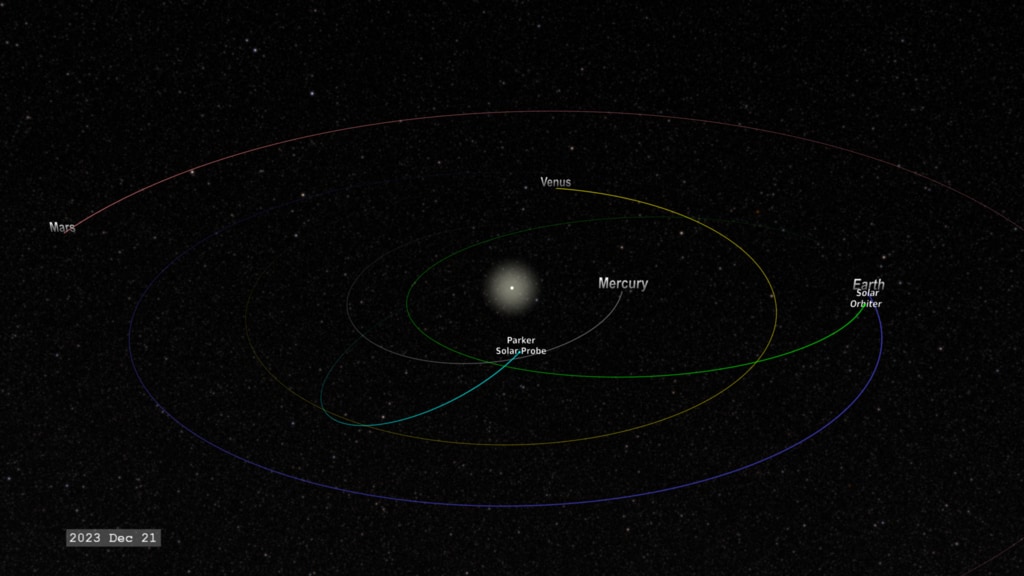Coordinated Heliosphere - How Solar Missions Work Together
Using Solar Orbiter, Parker Solar Probe, and other sun-observing missions, in coordinated observations, we can learn far more about the solar atmosphere which surrounds and impacts Earth and other missions in space, crewed and uncrewed.
This visualization presents an oblique view of the inner solar system with the various solar-observing missions conducting coordinated observations of the plasma environment. This version slows to 1/8 speed during the identified encounters to more easily view the spacecraft configurations.
In these visualizations, we show the orbits of the inner planets, along with orbits of multiple solar missions: STEREO-A, Parker Solar Probe, Solar Orbiter, and SOHO at the Earth-Sun L1 Lagrange point.
The Parker spiral created by the solar magnetic field is represented by the magenta spiral lines emanating out from and rotating with the Sun.
During encounters, spacecraft conducting in situ measurements are highlighted.
Spacecraft doing imaging have a semi-transparent conical or rectangular frustum representing the field of view of the camera.
In addition to direct 'line-of-sight' conjunctions, the spacecraft can have 'magnetic' conjunction's where they are both crossing the same outward magnetic field line in the solar wind. This configuration is represented by a wide magenta band, spiraling along lines similar to the solar magnetic field lines. The bands are represented as broad since the precise timing of these alignments may depend on local conditions such as the solar wind speed. In these configurations, it is hoped to compare charged particle flows along the solar magnetic field lines.
In many encounters, the imaging is performed while another spacecraft is passing through the camera field of view conducting in situ measurements. Those images will provide a global view of the region through which the spacecraft is traversing, providing additional context for interpreting the in situdata.
To facilitate identification of these encounters in the visualizations, a tabular list is presented below. The table identifies which instruments may conduct imaging while others are doing in situ measurements.
| Encounter Window (yyyy-mm-dd) | Imagers | in situ Instruments |
|---|---|---|
| 2020-09-11 to 2020-09-29 | STEREO-A, Solar Orbiter | Parker |
| 2021-01-14 to 2021-01-18 | STEREO-A, SOHO, Solar Orbiter | Parker |
| 2021-04-24 to 2021-05-01 | STEREO-A, SOHO, Solar Orbiter | Parker |
| 2021-08-07 to 2021-08-20 | STEREO-A, SOHO, Solar Orbiter | Parker |
| 2021-09-18 to 2021-09-18 | Parker, Solar Orbiter, STEREO-A | |
| 2021-11-19 to 2021-11-23 | STEREO-A, SOHO, Solar Orbiter | Parker |
| 2022-02-23 to 2022-02-27 | STEREO-A, SOHO, Solar Orbiter | Parker |
| 2022-04-05 to 2022-04-05 | Parker, Solar Orbiter | |
| 2022-05-29 to 2022-06-05 | STEREO-A, SOHO, Solar Orbiter | Parker |
| 2022-09-04 to 2022-09-07 | Solar Orbiter | Parker |
| 2022-10-20 to 2022-10-20 | Parker, Solar Orbiter | |
| 2022-12-09 to 2022-12-12 | Solar Orbiter | Parker |
| 2023-03-16 to 2023-03-20 | Solar Orbiter | Parker, SOHO |
| 2023-04-17 to 2023-04-17 | Parker, Solar Orbiter | |
| 2023-06-20 to 2023-06-27 | SOHO, Solar Orbiter, STEREO-A | Parker |
| 2023-06-20 to 2023-06-27 | SOHO, Solar Orbiter, STEREO-A | Parker |
| 2023-09-27 to 2023-10-05 | STEREO-A, SOHO, Solar Orbiter | Parker |
| 2023-10-12 to 2023-10-12 | SolarOrbiter, Parker | |
| 2023-12-27 to 2023-12-29 | Solar Orbiter, STEREO-A, SOHO | Parker |
| 2024-03-28 to 2024-04-08 | STEREO-A, SOHO, Solar Orbiter | Parker |
This visualization presents a top-down view of the inner solar system with the various solar-observing missions conducting coordinated observations of the plasma environment. This version plays at a uniform time rate.
This visualization presents an oblique view of the inner solar system with the various solar-observing missions conducting coordinated observations of the plasma environment. This version plays at a uniform time rate.
Other Notable Events
- STEREO-A was rotated while on the far side of the Sun from Earth so the HI-1 imager was viewing the region of space between the Sun and Earth. Around mid-August 2023, STEREO-A will pass Earth in its orbit and the spacecraft will be rotated again so HI-1 will view the region between Sun and Earth. This maneuver will put it back in the orientation it had after launch in 2006.
Credits
Please give credit for this item to:
NASA's Scientific Visualization Studio
-
Visualizer
- Tom Bridgman (Global Science and Technology, Inc.)
-
Scientists
- Teresa Nieves-Chinchilla (Catholic University of America)
- Chris St. Cyr (NASA/GSFC)
- William T. Thompson (ADNET Systems, Inc.)
- Angelos Vourlidas (Johns Hopkins University/APL)
-
Writer
- Miles S. Hatfield (Telophase)
-
Technical support
- Laurence Schuler (ADNET Systems, Inc.)
- Ian Jones (ADNET Systems, Inc.)
Release date
This page was originally published on Monday, December 7, 2020.
This page was last updated on Monday, January 6, 2025 at 12:17 AM EST.
Missions
This page is related to the following missions:Related papers
Datasets used
-
SPICE Ephemerides (SPICE Ephemerides)
ID: 755Satellite and planetary ephemerides
See all pages that use this dataset
Note: While we identify the data sets used on this page, we do not store any further details, nor the data sets themselves on our site.

![This visualization opens with a top-down view, then transtions to an oblique view of the inner solar system with the various solar-observing missions conducting coordinated observations of the plasma environment. This version displays the imaging instrument camera frustums and solar magnetic field alignments - the 'glyph' version. A version with just the orbits, no 'glyphs' is available in the [Download Options] menu.](/vis/a000000/a004900/a004970/SolarSynergiesPlus.Encounter2022FebTop2Side.HAE.AU.glyphs_CRTT.HD1080.01300_print.jpg)
